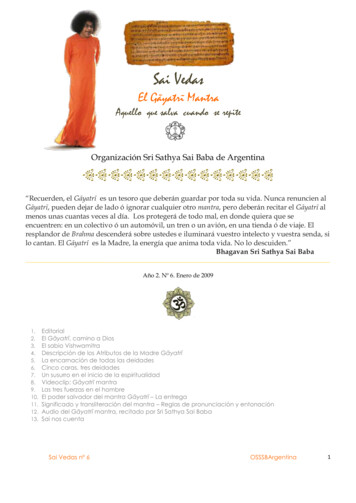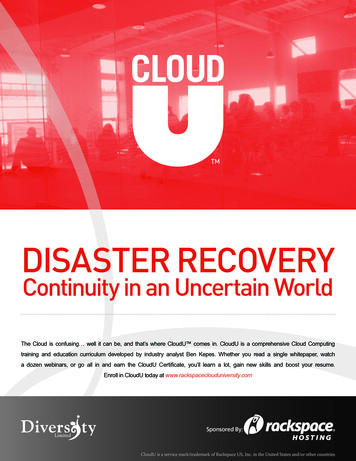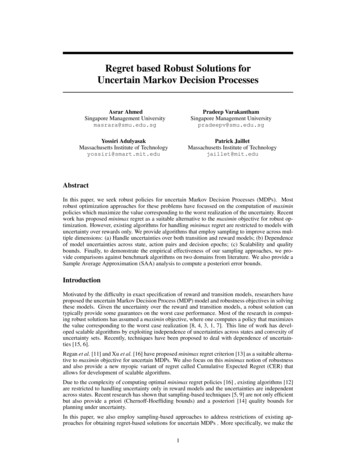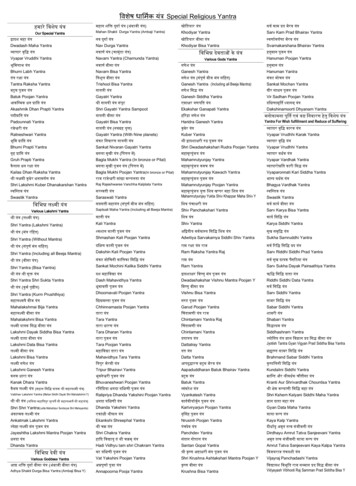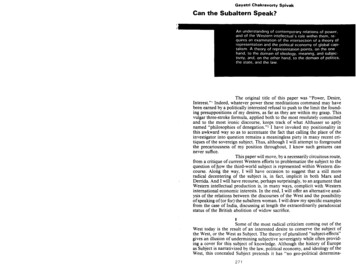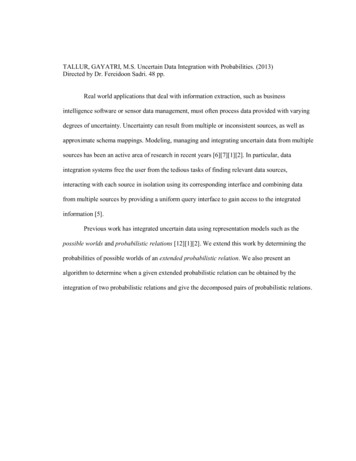
Transcription
TALLUR, GAYATRI, M.S. Uncertain Data Integration with Probabilities. (2013)Directed by Dr. Fereidoon Sadri. 48 pp.Real world applications that deal with information extraction, such as businessintelligence software or sensor data management, must often process data provided with varyingdegrees of uncertainty. Uncertainty can result from multiple or inconsistent sources, as well asapproximate schema mappings. Modeling, managing and integrating uncertain data from multiplesources has been an active area of research in recent years [6][7][1][2]. In particular, dataintegration systems free the user from the tedious tasks of finding relevant data sources,interacting with each source in isolation using its corresponding interface and combining datafrom multiple sources by providing a uniform query interface to gain access to the integratedinformation [5].Previous work has integrated uncertain data using representation models such as thepossible worlds and probabilistic relations [12][1][2]. We extend this work by determining theprobabilities of possible worlds of an extended probabilistic relation. We also present analgorithm to determine when a given extended probabilistic relation can be obtained by theintegration of two probabilistic relations and give the decomposed pairs of probabilistic relations.
UNCERTAIN DATA INTEGRATIONWITH PROBABILITIESbyGayatri TallurA Thesis Submitted tothe Faculty of The Graduate School atThe University of North Carolina at Greensboroin Partial Fulfillmentof the Requirements for the DegreeMaster of ScienceGreensboro2013Approved by.Dr. Fereidoon SadriCommittee Chair.
APPROVAL PAGEThis thesis written by GAYATRI TALLUR has been approved by the following committeeof the Faculty of The Graduate School at The University of North Carolina at Greensboro.Committee Chair Dr. Fereidoon SadriCommittee Members Dr. Nancy GreenDr. Jing DengNovember 7, 2013.Date of Acceptance by CommitteeNovember 7, 2013. .Date of Final Oral Examinationii.
ACKNOWLEDGEMENTSI sincerely thank my advisor, Dr. Fereidoon Sadri, for his abundant guidance and supportthroughout the course of this research without which this thesis would not have been possible. Iam very thankful to him for giving me the opportunity to work with him and believing in me. Ithoroughly enjoyed working under him. I would also like to thank Dr. Jing Deng and Dr. NancyGreen for their valuable guidance and feedback.I am indebted to my husband for his constant encouragement, support and love. I am verygrateful to my mother and my family members for their unconditional support and care. I want tothank Nina Revankar and her family for their ample love and concern during my study. Nina’sspontaneous gestures of help on those busy days really made a big difference, and I am deeplyindebted to her for it.I would like to express my gratitude to my friends at School for cheering me up andencouraging me all through. I am highly grateful to all my dear friends in Greensboro for keepingmy life outside School fun at all times, and for their endless concern and support throughout.iii
TABLE OF CONTENTSPageLIST OF TABLES . viLIST OF FIGURES . viiiCHAPTERI. INTRODUCTION . 11.1 Sources of Uncertainty in Data . 11.1.1 Measurement Errors . 21.1.2 Multiple or Inconsistent Sources . 21.1.3 Approximate Schema Mapping . 21.2 Modeling Uncertain Data. 31.2.1 Possible Worlds Model . 31.2.2 Probabilistic Relation Model (pr-relation) . 41.3 Managing Uncertain Data . 51.4 Data Integration . 61.5 Contributions from This Work. 6II. BACKGROUND INFORMATION . 82.1 Data Integration using the Possible Worlds Modelwithout probabilities . 82.2 Data Integration using the Possible Worlds Modelwith probabilities . 102.3 Data Integration using the Probabilistic Relation Modelwithout probabilities . 122.3.1 Integration Algorithm for Sources with epr-relations . 132.4 Motivation for This Work . 142.5 The Conversion Algorithm . 152.5.1 Determining the Probabilities of the Event Variables . 152.5.2 Forming the pr-relations . 16III. PROBABILITIES FOR UNCERTAIN DATA INTEGRATION . 213.1 Computing Probabilities in Data Integration . 213.1.1 Using the pr-relations. 213.1.2 Using the epr-relation . 223.2 Introducing Notations . 223.3 Event Variable Formula (EVF). 233.3.1 EVF Corresponding to a pr-relation . 233.3.2 EVF Corresponding to an epr-relation. 253.4 Computing the Probabilities from the EVF . 27iv
3.5 Example for Determining the Probabilities . 273.5.1 EVF using the pr-relation . 273.5.2 EVF using the epr-relation. 283.5.3 Calculating the Probabilities from the EVF . 29IV. FORMAL RESULTS . 304.1 Results. 304.2 Sufficient Conditions for an epr-relation to be Integrated . 314.2.1 The Decomposition Algorithm . 324.2.2 Examples. 344.3 Theorem 4 . 364.3.1 Example . 384.4 Theorem 5 . 394.4.1 Example . 414.5 Theorem 6 . 424.5.1 Example . 42V. CONCLUSIONS AND FUTURE WORK . 455.1 Conclusions. 455.2 Future Work . 45REFERENCES . 47v
LIST OF TABLESPageTable 1. Possible Worlds Model for Representing Uncertain Data . 3Table 2. Probabilistic Relation Model for Representing Uncertain Data . 5Table 3. Possible Worlds Model for Sources S1 and S2 . 9Table 4. Possible Worlds of Source S1 . 11Table 5. Possible Worlds of source S2 . 12Table 6. pr-relation for Source S1 and S2. 14Table 7. Integrated epr-relation. 14Table 8. Description of the Tuples . 17Table 9. Possible worlds for Source S1 . 18Table 10. Possible Worlds for Source S2 . 19Table 11. Truth Assignments for Source S1 . 19Table 12. Possible Worlds for Source S2 . 19Table 13. pr-relations for Source S1 . 20Table 14. pr-relations for Source S2 . 20Table 15. pr-relations for Sources S1 and S2. 28Table 16. epr relation for the Result of Integration. 28Table 17. epr-relation . 35Table 18. pr-relation r, s for Sources S1 and S2 (Pair #1) . 35Table 19. pr-relation r, s for Sources S1 and S2 (Pair #2) . 35Table 20. epr-relation . 35Table 21. epr-relation q . 38Table 22. pr-relations r and s . 38vi
Table 23. pr-relations r’ and s’ . 39Table 24. epr-relation q . 41Table 25. pr-relation r and s . 41Table 26. epr-relation q . 42Table 27. pr-relations r and s . 43Table 28. pr-relations r’ and s’ . 44vii
LIST OF FIGURESPageFigure 1. Result of Integrating with the Corresponding Probabilities . 13Figure 2. Possible worlds of q. 43Figure 3. Consistency Graph. 44viii
CHAPTER IINTRODUCTIONReal world applications that deal with information extraction, such as sensor datamanagement, Optical Character Recognition (OCR), data mining in social networks,deduplication and data cleaning or even business intelligence software, must often process dataprovided with varying degrees of certainty. Useful information is usually obtained from theavailable data by tracing the relevant data sources, interacting with each source in isolation usingits corresponding interface and combining data from all the sources. With the growing number ofsuch applications today, it is important that the user be able to pose complex queries and retrieveinformation in a very efficient and scalable manner. Given the imprecise nature of information inthe real world, processing and integrating uncertain data continues to be a challenging area ofresearch.1.1Sources of Uncertainty in DataIn the context of information retrieval systems, uncertainty could manifest itself for manyreasons including it being the outcome of flawed data, or missing knowledge. While flawed datacan result from recording errors during the process of data collection or entry, missing knowledgecan result from the inability to fill gaps in the collected data. Both these issues can be addressedby enumerating all possibilities for the corrupt or missing data and assigning a degree oflikelihood to them. Thus, information retrieval systems that operate on uncertain data glean usefulinformation from all available and enumerated data to provide results that are most likely to betrue. In the ensuing lines, we categorize the sources of uncertainty and provide examples for eachof them.1
1.1.1Measurement ErrorsConsider the example of a sensor management system that must process the readings fromtwo sensors reporting the temperature for the same city. If one recorded a value of 70F and theother recorded 72F, then the sensor data can be classified as Uncertain simply because they arenot matching precisely.1.1.2Multiple or Inconsistent SourcesConsider the example of two students S1 and S2 who provide information regarding thecourses that another student Bob has registered for in the current semester. Student S1 claims thatBob has enrolled for CS100 or CS101 while student S2 claims that Bob is enrolled for CS101 orCS102. Clearly, the courses that Bob is registered for can be classified as Uncertain. Alongsimilar lines, sources that provide data that is deemed inconsistent also lead to uncertainty.1.1.3Approximate Schema MappingConsider the example of two schemas, Student (Name, SSN, Marks) and Grad-Student(Name, ID, Grades). If every Grade in Grad-Student.Grades maps uniquely to every Marks inStudent.Marks, then this one-to-one mapping ensures definite results. However, if each Grade inGrad-Student.Grades maps to a range of Marks in Grad-Student.Marks, then this approximatemapping introduces uncertainty.For every source of uncertainty discussed above, uncertain data cannot be processed withinthe confines of a traditional database information retrieval system as easily. Not only is it morecomplicated to process, but it is also less efficient [11]. Processing such data begins withmodeling uncertain data differently. In fact, research in recent times has focused on addressingthe modeling techniques and managing such data [1][6][7].2
1.2Modeling Uncertain DataTraditional databases do not allow scope for handling information retrieval errors resultingfrom flawed data or missing knowledge. A strong need is felt for a database that can modeluncertain data and allow multiple values based on user-defined confidence levels. The ensuingsections discuss the different modeling techniques that such uncertain databases could use torepresent uncertain data.1.2.1Possible Worlds ModelThe possible worlds model has been widely accepted as a conceptual model of uncertaininformation. In this model, the information represented by each source is distributed over manytraditional database instances, each instance being a possible state of the real world [1]. Eachpossible world is simply a traditional database containing data without any uncertainty.Table 1. Possible Worlds Model for Representing Uncertain DataPossible World {D1}TupleLocationTemperaturet1GreensboroPossible World {D2}70FInvalid Possible World alid Possible World {D4}ɸTable 1 shows the four database instances for the example presented in Section 1.1.1. From Table1 however, Possible World {D3} is invalid because it is improbable that a single location hasdifferent temperature readings simultaneously. Furthermore, Possible World {D4} is invalid3
because the place must have a temperature reading associated with it. Thus, the relevant possibleworlds are simply {D1} and {D2}.As the amount of uncertain data increases, the number of possible worlds also increasesexponentially. The resulting representation for uncertain data becomes unwieldy and processingtime becomes unacceptably large. Therefore, we resort to the probabilistic relation model whichserves as a more compact representation, by helping avoid enumerating all the possible worlds.1.2.2Probabilistic Relation Model (pr-relation)The uncertain database that chooses to model its data using the possible worlds model usesmultiple schemas to represent all the possible enumerations of uncertain data. In contrast, theprobabilistic relation model [3] uses only one schema with one additional attribute known as theEvent attribute (E). Unique atomic events across all possible worlds are expressed using Booleanvariables, or event variables, and are combined using logic expressions to create complex eventsthat are assigned to the attribute E for all tuples in the schema. In other words, the attribute E forevery tuple in the schema is simply a Boolean True or False value. For the example presented inSection 1.1.1, the atomic events “The temperature in Greensboro is 70F” and “The temperaturein Greensboro is 72F” are represented by the event variable x and y respectively. The atomicevent y may be interpreted as x for purposes of simplification. The truth value for x representsthe corresponding possible worlds.Table 2 shows the probabilistic relation for the example discussed above. The individualrows or tuples are simply represented by the variables t1 and r1 respectively. Thus, when x isTrue, only t1 is True representing Possible World {D1} and when x is False, only r1 is Truerepresenting Possible World {D2}.4
The probabilistic relations model is equivalent to the possible worlds model, and the work of[13] formally shows that in fact the probabilistic relation model can represent any possible worldsset.Table 2. Probabilistic Relation Model for Representing Uncertain DataTupleLocationTemperatureEvent Attribute (E)t1Greensboro70Fxr1Greensboro72F xAn uncertain database can utilize the modeling techniques described in Section 1.2.1 and 1.2.2,and assign probabilities to every possible world representing the degree of belonging to thedatabase. The sum of these probabilities over all possible worlds in the database should be equalto 1. Such a database is then known as a Probabilistic Database. A Probabilistic Database for theexample shown in Table 1, for all possible worlds with equal probabilities, might be depicted asP(D1) 0.5 and P(D2) 0.5.1.3Managing Uncertain DataManaging uncertain data refers to the set of operations that are used to store data, modify itand extract useful information. Operations such as indexing, join processing and query evaluationmust be redesigned to handle uncertain data properly. Each of these is an active area of researchand query processing for probabilistic databases is still, in fact, in its infancy. Little is knownabout which queries can be evaluated in polynomial time, and the few existing evaluationmethods employ expensive main-memory algorithms [10].5
1.4Data IntegrationOften, applications need to retrieve consolidated information using data stored in multipleuncertain databases that have the same schema. The process of consolidating all the available dataacross various databases is known as Data Integration. Data integration is important becauseintegrating multiple sources of uncertain data can help resolve some uncertainty, yielding moreaccurate results than any of the individual sources [4]. The importance of information integrationfor uncertain data has been realized in recent years. In fact, [1] makes the following relevantobservation:While in traditional database management managing uncertainty and lineage seems like anice feature, in data integration it becomes a necessity.The result of integration is useful only to the extent that the information it produces can betrusted. Hence, providing a confidence value to the integrated information is a necessity in manyapplications [1]. This work concentrates on integrating two probabilistic databases anddetermining the probabilities of the possible worlds in the integration. The challenge here lies inaccurately determining the probabilities.1.5Contributions from This WorkThe work of [1] has developed methods to integrate uncertain databases with and withoutknown associated probabilities using the possible worlds model. On the other hand, the work of[2] has developed a method to integrate uncertain databases using the probabilistic relationsmodel without considering the associated probabilities. Our work extends the work of [2] towardsuncertain data integration in the following manner. We present two methods to determine the probabilities of the possible worlds in theintegration of two uncertain databases associated with a known set of probabilities.6
We show that both these methods are equivalent. We give sufficient conditions that an extended probabilistic relation can be obtained bythe integration of two probabilistic relations. We present the decomposition algorithm that determines if a given extended probabilisticrelation can be obtained by the integration of two probabilistic relations and gives thedecomposed pairs of probabilistic relations. Given the result of integration whose decomposition leads to multiple pairs ofprobabilistic relations, we show that all pairs are equivalent.This work is organized as follows. Chapter II discusses all relevant previous work. ChaptersIII and IV present our work and results. Finally, Chapter V presents the conclusions and the scopefor future research.7
CHAPTER IIBACKGROUND INFORMATIONThis chapter summarizes the work done so far towards integrating data from uncertaindatabases. Towards this end, we discuss the use of the Possible Worlds model to integrateinformation from two uncertain databases across two different scenarios, as presented in the workof [1] – firstly, when the information is not associated with known probabilities and secondly,when it is. We also highlight the use of the Probabilistic Relation model to integrate informationfrom uncertain databases when the information is not associated with probabilities, as presentedin the work of [2]. In this work, we extend these ideas towards using the Probabilistic Relationmodel to integrate information from uncertain databases associated with known probabilities todetermine the probabilities of the result of integration.2.1Data Integration using the Possible Worlds Model without probabilitiesThe work of [12] uses the well-known possible worlds model to represent and integrateuncertain information from two uncertain sources using superset-containment. The work of [1]uses the same model to represent and integrate uncertain information. It introduces a simple logicbased approach for doing the integration. Since [1] forms the basis for this research, wesummarize the procedure below.Given an uncertain source U with T(U) representing the finite set of tuples of U, apropositional variable ti is assigned to each tuple in T(U). A formula corresponding to eachpossible world (D) for a source is built by conjuncting all variables ti where the corresponding8
tuple is in Dj, and conjuncting ti where the corresponding tuple is not in Dj. The formulacorresponding to the uncertain database U is then the disjunction of the formulae correspondingto the possible worlds of U.The formula f corresponding to the uncertain database resulting from integrating U1 . . . Un isobtained by conjuncting the formulae of the databases: f f1 . . . fn. This procedure is bestdemonstrated through an example we present next. Let us consider the two friends of Bill who areproviding information about his course registrations during Fall 2013. We refer to the first friendas Source S1 and the second one as Source S2. Let S1 state that Bill is taking CS100 or CS101(but not both). Let S2 state that Bill is taking CS101 or CS102 (but not both). The correspondingpossible worlds for this example are:Table 3. Possible Worlds Model for Sources S1 and 02Let variable t1 and t2 correspond to each of tuples (Bill, CS100) and (Bill, CS101) respectively.Then the formula for the first possible world, second possible world, and the database are,respectively,t1 t2, t1 t2, and (t1 t2) V ( t1 t2)Let t2 and t3 correspond to (Bill, CS101) and (Bill, CS102) respectively. Then the formulacorresponding to the uncertain database representing S2 is as shown next.9
(t2 t3) V ( t2 t3)The integration is then obtained as,[(t1 t2) V ( t1 t2)] [(t2 t3) V ( t2 t3)]Simplifying this Boolean expression yields( t1 t2 t3)V(t1 t2 t3)We interpret this to mean that the two possible worlds upon integration are, (Bill registered forCS101) or (Bill registered for both CS100 and CS102).2.2Data Integration using the Possible Worlds Model with probabilitiesThe integration approach developed in Section 2.1 is extended to deal with integratinguncertain information associated with known probabilities and determine the probabilities of thepossible worlds in the integration [1]. Given a probabilistic uncertain database U with PW(U) {D1, . . . , Dm}, it is convenient to associate a probabilistic event ei with each possible world Di.Intuitively, if ei represents the event where the value of the uncertain database U is equal to Di,then the probability of ei, P(ei) pi.The work of [1] shows that the probabilistic consistency constraint has to be satisfied forperforming uncertain data integration. It states that the sum of probabilities of the possible worldscorresponding to the first source should be equal to the sum of probabilities of the possible worldscorresponding to the second source for the possible worlds that are integrating. When possibleworlds from different sources satisfy the consistency constraints, then the probabilities ofintegration are obtained in terms of the probabilities of the individual sources by usingconditional probability : P(ej ek) P(ej ek) * P(ek). If ej and ek are inconsistent, then P(ej ek) 0.10
If possible worlds D and D’ are connected in the consistency graph, and not connected to anyother nodes, then P(D) P(D’) and P(D D’) P(D) P(D’), otherwise the probability isobtained by distributing the sum according to the pairwise product of probabilities of underlyingpossible worlds as shown in the ensuing example.Consider the possible worlds of two sources shown in Table 4 and Table 5.Table 4. Possible Worlds of Source S101CS103D3StudentBillCourseCS103Let the probabilities of the possible worlds in the two sources be P(D1) 0.3, P(D2) 0.5,P(D3) 0.2, P(D1’) 0.35, P(D2’) 0.45, P(D3’) 0.05, and P(D4’) 0.15.The lines in Figure 1 connecting S1 to S2 represent the possible worlds that are consistentand can integrate. There are two connected components in this consistency graph. The possibleworlds in the result of integration are shown on right. The probabilistic consistency constraintsP(D1) P(D2) P(D1’) P(D2’) and P(D3) P(D3’) P(D4’) are satisfied.The probabilities of the integrated possible worlds are calculated in the following way.P(D3 D3’) P(D3 D3’) * P(D3’) P(D3’) 0.05,P(D3 D4’) P(D3 D4’) * P(D4’) P(D4’) 0.1511
Table 5. Possible Worlds of source dentBillBillCourseCS102CS100The probability of the remaining four possible worlds in the integration is obtained by distributingthe sum (0.8) according to the pairwise product of probabilities of underlying possible worlds.P(D1 D1’) P(D1 D1’) * P(D1’) P(D1) / [P(D1) P(D2)] * P(D1’) 0.13125P(D1 D2’) P(D1 D2’) * P(D2’) P(D1) / [P(D1) P(D2)] * P(D2’) 0.16875P(D2 D1’) P(D2 D1’) * P(D1’) P(D2) / [P(D1) P(D2)] * P(D1’) 0.21875P(D2 D2’) P(D2 D2’) * P(D2’) P(D2) / [P(D1) P(D2)] * P(D2’) 0.28125Since (D2 D2’) has the highest probability upon integration, the possible world (Bill registeredfor CS101, CS103 and CS102) is the most likely solution of integration.2.3Data Integration using the Probabilistic Relation Model without probabilitiesMoving on from the Possibl
TALLUR, GAYATRI, M.S. Uncertain Data Integration with Probabilities. (2013) Directed by Dr. Fereidoon Sadri. 48 pp. Real world applications that deal with information extraction, such as business . modeling uncertain data differently. In fact, research in recent times has focused on addressing

